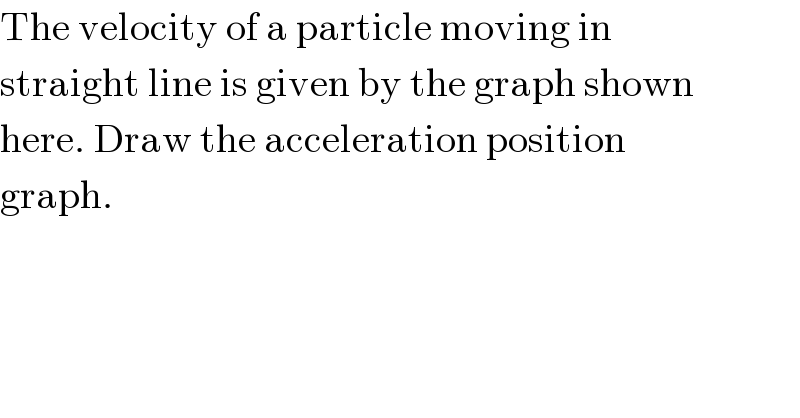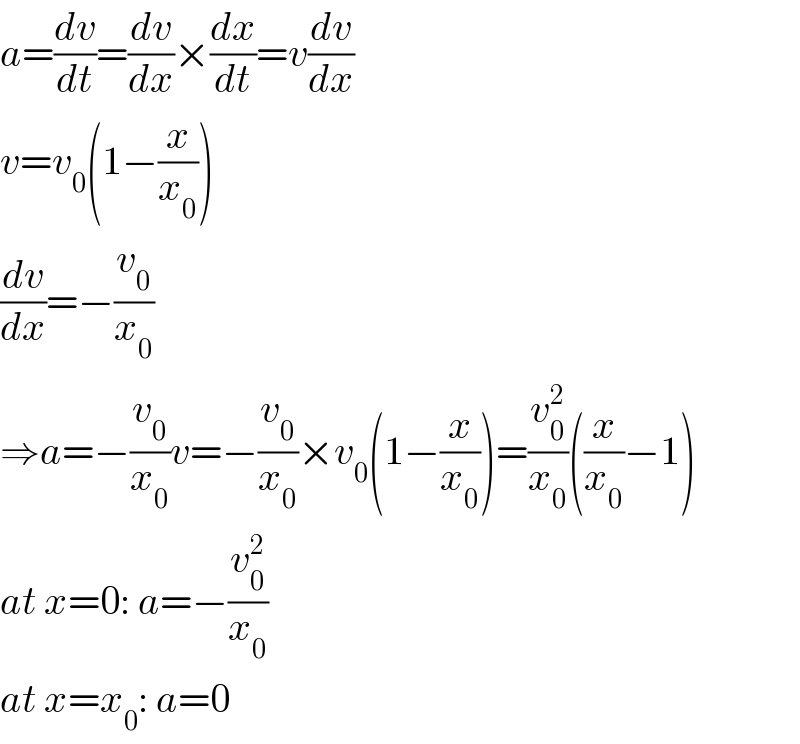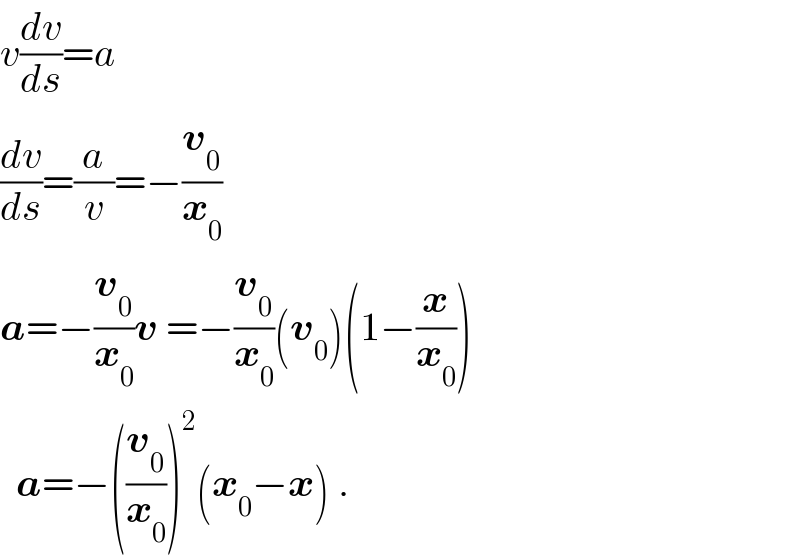
Question Number 13745 by Tinkutara last updated on 23/May/17

$$\mathrm{The}\:\mathrm{velocity}\:\mathrm{of}\:\mathrm{a}\:\mathrm{particle}\:\mathrm{moving}\:\mathrm{in} \\ $$$$\mathrm{straight}\:\mathrm{line}\:\mathrm{is}\:\mathrm{given}\:\mathrm{by}\:\mathrm{the}\:\mathrm{graph}\:\mathrm{shown} \\ $$$$\mathrm{here}.\:\mathrm{Draw}\:\mathrm{the}\:\mathrm{acceleration}\:\mathrm{position} \\ $$$$\mathrm{graph}. \\ $$
Commented by Tinkutara last updated on 23/May/17

Answered by mrW1 last updated on 23/May/17

$${a}=\frac{{dv}}{{dt}}=\frac{{dv}}{{dx}}×\frac{{dx}}{{dt}}={v}\frac{{dv}}{{dx}} \\ $$$${v}={v}_{\mathrm{0}} \left(\mathrm{1}−\frac{{x}}{{x}_{\mathrm{0}} }\right) \\ $$$$\frac{{dv}}{{dx}}=−\frac{{v}_{\mathrm{0}} }{{x}_{\mathrm{0}} } \\ $$$$\Rightarrow{a}=−\frac{{v}_{\mathrm{0}} }{{x}_{\mathrm{0}} }{v}=−\frac{{v}_{\mathrm{0}} }{{x}_{\mathrm{0}} }×{v}_{\mathrm{0}} \left(\mathrm{1}−\frac{{x}}{{x}_{\mathrm{0}} }\right)=\frac{{v}_{\mathrm{0}} ^{\mathrm{2}} }{{x}_{\mathrm{0}} }\left(\frac{{x}}{{x}_{\mathrm{0}} }−\mathrm{1}\right) \\ $$$${at}\:{x}=\mathrm{0}:\:{a}=−\frac{{v}_{\mathrm{0}} ^{\mathrm{2}} }{{x}_{\mathrm{0}} } \\ $$$${at}\:{x}={x}_{\mathrm{0}} :\:{a}=\mathrm{0} \\ $$
Commented by mrW1 last updated on 23/May/17

Commented by Tinkutara last updated on 23/May/17

$$\mathrm{Thanks}! \\ $$
Answered by ajfour last updated on 23/May/17

$${v}\frac{{dv}}{{ds}}={a} \\ $$$$\frac{{dv}}{{ds}}=\frac{{a}}{{v}}=−\frac{\boldsymbol{{v}}_{\mathrm{0}} }{\boldsymbol{{x}}_{\mathrm{0}} } \\ $$$$\boldsymbol{{a}}=−\frac{\boldsymbol{{v}}_{\mathrm{0}} }{\boldsymbol{{x}}_{\mathrm{0}} }\boldsymbol{{v}}\:=−\frac{\boldsymbol{{v}}_{\mathrm{0}} }{\boldsymbol{{x}}_{\mathrm{0}} }\left(\boldsymbol{{v}}_{\mathrm{0}} \right)\left(\mathrm{1}−\frac{\boldsymbol{{x}}}{\boldsymbol{{x}}_{\mathrm{0}} }\right) \\ $$$$\:\:\boldsymbol{{a}}=−\left(\frac{\boldsymbol{{v}}_{\mathrm{0}} }{\boldsymbol{{x}}_{\mathrm{0}} }\right)^{\mathrm{2}} \left(\boldsymbol{{x}}_{\mathrm{0}} −\boldsymbol{{x}}\right)\:. \\ $$
Commented by Tinkutara last updated on 23/May/17

$$\mathrm{Thanks}! \\ $$
Commented by mrW1 last updated on 23/May/17

$${Can}\:{you}\:{draw}\:{the}\:{position}−{time} \\ $$$${curve}\:{please}? \\ $$
Commented by ajfour last updated on 23/May/17

Commented by ajfour last updated on 23/May/17

$$\boldsymbol{{x}}=\boldsymbol{{x}}_{\mathrm{0}} \left(\mathrm{1}−\boldsymbol{{e}}^{−\boldsymbol{{v}}_{\mathrm{0}} \boldsymbol{{t}}/\boldsymbol{{x}}_{\mathrm{0}} } \right) \\ $$
Commented by mrW1 last updated on 23/May/17

$${that}\:{means}\:{the}\:{point}\:{x}={x}_{\mathrm{0}} \:{can}\:{never} \\ $$$${be}\:{reached},\:{since}\:{x}\left({t}\right)<{x}_{\mathrm{0}} \\ $$
Commented by ajfour last updated on 23/May/17

$${yes},\:{i}\:{believe}\:{the}\:{same}.. \\ $$
